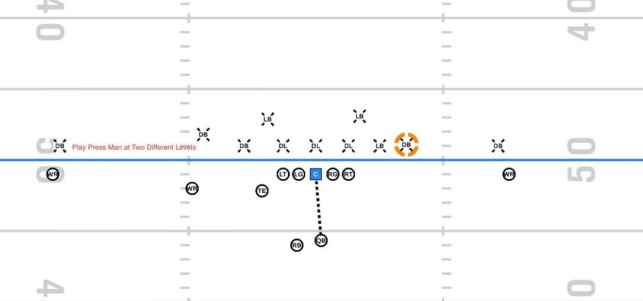By Brock McCullough
Defensive Coordinator
Shenandoah University (VA)
Twitter: @BrockMcCullough
Situational press man coverage has merit at most levels of football. Typically, our press man coverage is paired with bringing more defenders than the offense can block (Cover Zero). A quarterback allows defenses to outnumber the offense's protection. Press man eliminates the modern quick game, easy access, high percentage throws which offenses love to take. We teach a heavy inside press alignment to help discourage easy, in-breaking routes by the offense. This approach and alignment allow us to force out-breaking throws which are completed at a lower percentage. Our teaching progression starts thereby eliminating those types of throws simply by our alignment. A key point to this article is disruption. Press man is disruptive. Any wide receiver loves a free release. If he runs a 4.6 forty and is allowed a free release, he still runs his 4.6 forty. However, receivers at every level hate being disrupted. By disruption, they likely now will run a 5.0 forty because we are in the way as defenders. Also, you will often hear radio broadcasters and television commentary on how the receiver “dropped an easy touchdown pass.” What they hardly ever consider is that receivers hate to be touched. They often complain to the official when they are touched. The reason they likely dropped that "easy" touchdown pass is often because they were disrupted off of the line of scrimmage therefore, they dropped the pass three steps later. Or they have been disrupted with thoughts that a 230-pound linebacker was within a foot of their pattern. Disruption is especially important for defenses. This article will talk about one form of defensive disruption: press-man coverage.

Man coverage from a press position all starts with great alignment. We always start any coverage with alignment as the first thing on our checklist. We want our corners, nickel, and press safeties to take a hard-inside ability alignment. First, we want to educate you on the difference between a "man turn" and a “zone turn.” We drill these types of turns daily. A zone turn by a defender means that we see the quarterback and the ball throughout the entirety of the play. We feel this visual key increases our chances for turnovers and provides more eyes on the football for tackling. A man turn involves turning our back to the quarterback and the football while focusing our vision on our man. We feel this has merit at times throughout a football game as well. Man turn technique is what we will be focusing on in this article. Man coverage means we are canceling out one offensive player with one defensive player. We want to melt to this man and eliminate him. Our teaching progression for all coverages/concepts is A.S.K.I.R. I will take you through our press man Alignment, Stance, Keys, Initial reaction, and Responsibility.
Inside press man generally invites lower percentage throws to the perimeter of the field.
Defensive Coordinator
Shenandoah University (VA)
Twitter: @BrockMcCullough
Situational press man coverage has merit at most levels of football. Typically, our press man coverage is paired with bringing more defenders than the offense can block (Cover Zero). A quarterback allows defenses to outnumber the offense's protection. Press man eliminates the modern quick game, easy access, high percentage throws which offenses love to take. We teach a heavy inside press alignment to help discourage easy, in-breaking routes by the offense. This approach and alignment allow us to force out-breaking throws which are completed at a lower percentage. Our teaching progression starts thereby eliminating those types of throws simply by our alignment. A key point to this article is disruption. Press man is disruptive. Any wide receiver loves a free release. If he runs a 4.6 forty and is allowed a free release, he still runs his 4.6 forty. However, receivers at every level hate being disrupted. By disruption, they likely now will run a 5.0 forty because we are in the way as defenders. Also, you will often hear radio broadcasters and television commentary on how the receiver “dropped an easy touchdown pass.” What they hardly ever consider is that receivers hate to be touched. They often complain to the official when they are touched. The reason they likely dropped that "easy" touchdown pass is often because they were disrupted off of the line of scrimmage therefore, they dropped the pass three steps later. Or they have been disrupted with thoughts that a 230-pound linebacker was within a foot of their pattern. Disruption is especially important for defenses. This article will talk about one form of defensive disruption: press-man coverage.

Man coverage from a press position all starts with great alignment. We always start any coverage with alignment as the first thing on our checklist. We want our corners, nickel, and press safeties to take a hard-inside ability alignment. First, we want to educate you on the difference between a "man turn" and a “zone turn.” We drill these types of turns daily. A zone turn by a defender means that we see the quarterback and the ball throughout the entirety of the play. We feel this visual key increases our chances for turnovers and provides more eyes on the football for tackling. A man turn involves turning our back to the quarterback and the football while focusing our vision on our man. We feel this has merit at times throughout a football game as well. Man turn technique is what we will be focusing on in this article. Man coverage means we are canceling out one offensive player with one defensive player. We want to melt to this man and eliminate him. Our teaching progression for all coverages/concepts is A.S.K.I.R. I will take you through our press man Alignment, Stance, Keys, Initial reaction, and Responsibility.
Inside press man generally invites lower percentage throws to the perimeter of the field.









